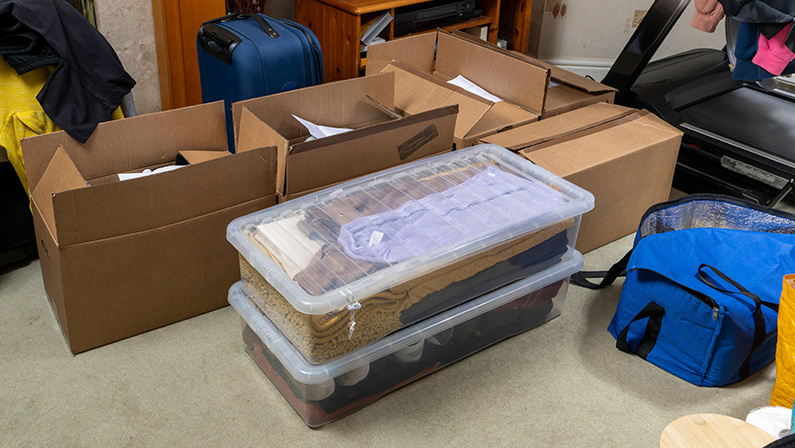Storing off season clothes may seem like a simple task, but doing it the right way can make all the difference in how well your clothes hold up over time. From preserving fabric quality to maximizing space, a little planning goes a long way. Without proper storage, clothes can suffer from mildew, wrinkles, fading, or even pest damage.
This guide will walk you through everything you need to know about how to store seasonal clothes effectively. Whether you’re dealing with bulky winter coats or lightweight summer dresses, these seasonal clothes storage ideas will keep your wardrobe in top shape for the next season.
Why Is Proper Storage of Off-Season Clothes Important?
Proper storage of off-season clothing helps preserve fabric integrity, prevent pest damage, and free up valuable space in your closet. When clothes are stored without care, they can develop permanent creases, fading, and mildew which ultimately shortens their lifespan. By following the best way to store off season clothes, you can protect your investment and make seasonal transitions easier and more organized.
When Should You Rotate and Store Off-Season Clothing?
Timing your seasonal clothing rotation depends on your climate, but a general rule is to swap your wardrobe twice a year in spring and fall. Watch the weather trends in your region and transition once the temperatures stabilize. By staying ahead of the curve, you can streamline the process of storing out-of-season clothes without last-minute stress.
How Should You Prepare Clothes Before Storing Them?
Before placing any item into storage, preparation is key. Wash or dry clean all garments to remove sweat, oils, and stains, which can attract pests or cause yellowing over time. Make sure everything is completely dry before packing to avoid trapping moisture, which can lead to mold and mildew.
What Materials Should You Use for Storing Off-Season Clothing?
The materials you use for storing off season clothes can significantly affect their condition.
Here are the best options to consider:
Plastic Storage Bins
Plastic bins are a durable choice for seasonal clothes storage. They protect against moisture and pests better than cardboard boxes, especially when sealed tightly.
Vacuum-Sealed Bags
These are excellent for bulky items like winter coats and blankets. Vacuum-sealed bags minimize space and keep out air and insects, although they’re not ideal for delicate fabrics.
Cotton Garment Bags
For storing out of season clothes made of silk, wool, or linen, breathable cotton garment bags prevent fabric damage and allow airflow, reducing moisture buildup.
How Do You Protect Stored Clothes from Moisture and Mold?
Moisture is the enemy of any seasonal clothing storage plan.
Use the following tips to keep your items dry and mold-free:
Use Silica Gel Packs
Place silica gel packets in storage containers to absorb moisture. They’re affordable and effective for small spaces.
Choose Climate-Controlled Storage
If storing clothes in a garage or attic, consider a climate-controlled storage solution to keep temperature and humidity in check.
Avoid Plastic Bags
Plastic shopping bags trap moisture, increasing the risk of mildew. Always opt for breathable or moisture-resistant materials instead.
What’s the Best Way to Store Delicate or Specialty Fabrics?

Delicate and specialty fabrics need extra care during storage.
Here’s how to preserve their quality:
Wrap in Acid-Free Tissue Paper
Place tissue paper between layers to prevent color transfer and creasing. This is especially useful for silk, satin, and lace items.
Store Flat When Possible
Delicate items like beaded garments should be stored flat to avoid stretching. Use padded containers or shallow boxes lined with fabric.
Avoid Mothballs
Use lavender sachets or cedar blocks instead of mothballs, which contain harsh chemicals that may damage fine fabrics.
Should You Fold or Hang Off-Season Clothes?
The answer depends on the type of clothing:
Fold Heavy Knits and Sweaters
Folding helps retain shape and prevents heavy fabrics from stretching out. Stack them loosely in bins or on shelves.
Hang Structured Garments
Items like blazers, dresses, and coats should be hung on padded or wooden hangers to keep their shape. Use garment bags to protect them from dust.
Don’t Overstuff
Give clothes breathing room to reduce wrinkles and avoid pressure points that can lead to damage over time.
How Can You Prevent Pests Like Moths and Silverfish?
Pests are a serious concern for out of season clothes storage.
Here’s how to keep them at bay:
Use Cedar and Lavender
Natural repellents like cedar blocks and lavender sachets deter moths and silverfish without leaving a harsh smell or residue.
Clean Storage Areas
Before placing clothes into storage, clean the area thoroughly to eliminate food crumbs and dust, which attract pests.
Inspect Regularly
Periodically check stored items for any signs of infestation. Early detection makes it easier to address problems before they spread.
Where Is the Best Place to Store Off-Season Clothes?

The location of your seasonal clothes storage plays a big role in keeping them safe:
Under the Bed
Use shallow containers or rolling bins to maximize this often-overlooked space. It’s accessible and usually safe from humidity.
Closet Shelves or Top Racks
High shelves work well for light bins or bags. Just ensure the space is cool, dry, and not exposed to direct sunlight.
Spare Room or Storage Unit
For large wardrobes, a dedicated closet or climate-controlled unit can provide ample space and ideal conditions for long-term storage.
How Should You Organize and Label Stored Clothing for Easy Access?
Organization makes seasonal transitions smoother and less frustrating:
Label Everything
Use clear, detailed labels on each container. Indicate the season, type of clothing, and even specific items if necessary.
Group by Category
Keep like items together: winter outerwear, summer dresses, workout gear, etc. This way, you’ll find what you need quickly when it’s time to swap.
Use Transparent Bins
If possible, choose clear bins so you can see what’s inside without opening them. It saves time and reduces handling.
Keep Your Wardrobe Ready Year-Round

Storing off season clothes doesn’t have to be a chore. With the right tools and strategies, you can keep your garments protected, organized, and ready for their next rotation. From proper preparation and pest prevention to using the best materials for seasonal clothes storage, the benefits of taking the time to do it right will show in the longevity and quality of your wardrobe.
For those in Chicago, IL looking to keep their clothes in top condition before storing them, the best laundromat in Chicago is SpinXpress Laundry. We offer professional laundry services that make storing out of season clothes even easier. Visit SpinXpress today!





